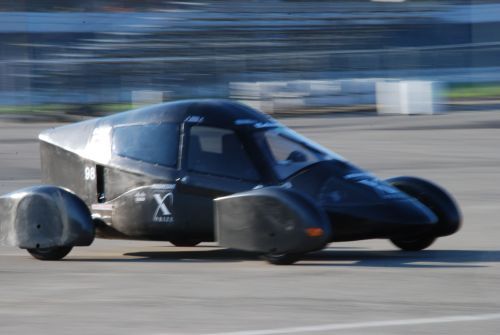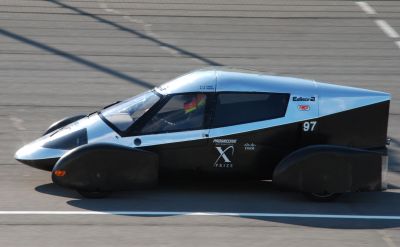Knockout Results
The knockout stage accomplished its goal and pared the X Prize field: the competition is now down from 21 teams and 26 vehicles to 12 teams and 15 vehicles. There are 8 vehicles left in the Alternative Side-by-Side class, 5 in the Alternative Tandem class and two in the Mainstream class.
The Alternative classes each come with a $2.5 M prize, and are less stringent than the Mainstream class. They require only a 100 mile range and 2 passengers; allow a slower 0 – 60 time, motorcycle tires and any number of wheels; and do not require features such as heat, air conditioning and audio. Edison2 has one car left in the Tandem class. The Mainstream class – $5 M prize, 4 wheels, 4 passengers, 200 mile range – is down to 2 cars: both are Edison2 Very Light Cars.
Our 3 remaining cars achieved combined MPGe (before penalties) of 101.4, 97.0 and 80.3: we feel we are well-positioned to meet the mileage and performance challenges of the finals.
The X Prize understands the importance of good handling to a safe and efficient car, and our cars aced the competition’s dynamic safety tests.
Edison2 had the top speed in the accident avoiding maneuver test (lane change). We had the shortest stopping distance in the 60 – 0 braking test, at 128 feet: 170 feet was the requirement.

We also bested the field in the lateral acceleration (skid pad) test, with our cars having the top three scores. For this test cars see how fast they can run in a 300’ diameter circle; our #97 mainstream car took 14.9 seconds to complete the circle, and achieved a 1.18g (g=acceleration due to gravity) peak reading, with 0.7g required. Compared with a car doing the minimum 0.7, our #97 would be 1.3 seconds and 75 feet ahead.
This is important: safety is achieved not just by performing well in a crash, but also by avoiding accidents altogether. The Very Light Cars are designed to meet both of these components of vehicle safety.
One of the cool things about these results is that Edison2's cars have the narrowest tires in the mainstream class. Unlike some of our competitors, we have not had to change them due to wear. Why are we able to combine grip, small size and low wear? Because the cars are Very Light.
Finals start July 19.
 Safety,
Safety,  Very Light Car,
Very Light Car,  X Prize
X Prize 

